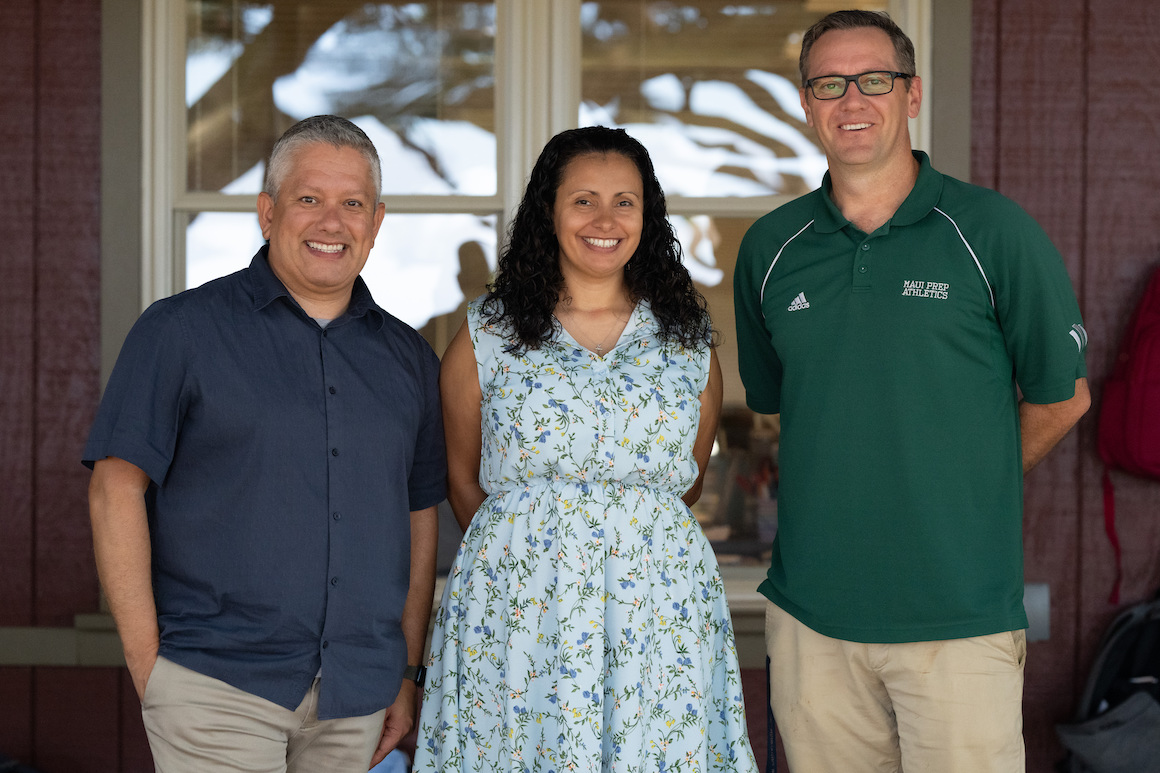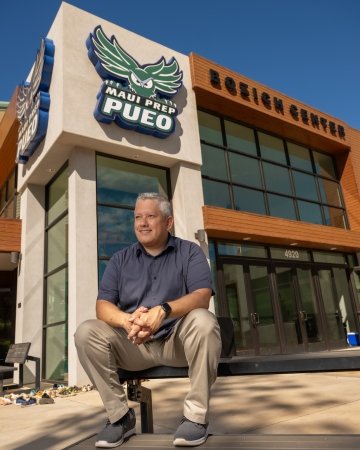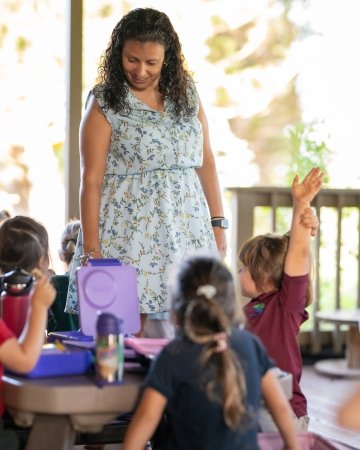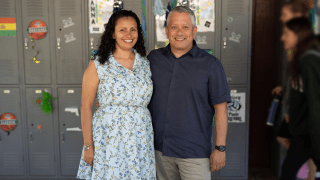On Monday, Aug. 7, 2023, Lisa Zamora EdD ’13 and her husband Miguel Solis EdD ’18 were excitedly preparing for Maui Preparatory Academy’s first day of school, set for Wednesday, Aug. 9. The non-profit private school, located in Napili, a small town on Maui’s west side about 10 miles north of Lahaina, serves students from preschool age to 12th grade.
The following day, Tuesday, Aug. 8, Miguel, head of school at Maui Prep, and Lisa, academic dean, woke to no power and cell phones flashing SOS. They heard there was a brushfire on the mountainside of Maui, but they didn’t think much of it—brush fires are fairly commonplace in West Maui. “We’ve had fires out here in the past,” Lisa explains. “They always get them contained pretty fast. In a way, we were a little desensitized because of previous years.”
The two went about their day, going down to Maui Prep to assess if the school had sustained any damage due to the high winds and prep for a possible opening the next day. But after consulting with board president, Jim Bozich, the first day of school was pushed back to Thursday. Miguel and Lisa returned home with a feeling of unease.
As the sun set that evening, Lisa and Miguel joined their neighbors and made use of their condo’s communal barbecues to cook dinner. The blaze to the south was growing, but with the power out and telecommunications still down, everyone was literally in the dark.
That night, Lisa and Miguel brought their seven-year-old son Noah into their room. They worried that the glow of the fire, visible from his window, would keep him up. But with the wind howling and the glow growing, sleep was elusive for everyone. At around 2:30 am, Miguel told Lisa he was going to Maui Prep to see if everything was OK. He told her that he would either be at the school or at the small airport nearby to attempt to get cell service.
Once at the airport, he was able to get a radio signal at the higher elevation and immediately heard the name of his school on the airwaves. He got in his car and raced down the hill to Maui Prep. He saw another massive glow—but this one was coming from floodlights that were lighting up the area for a number of buses and throngs of people.
As he drove into the school, the school’s principal, Ryan Kirkham, ran to his vehicle, headlamp on his head, and explained that the Maui police department knocked on his door earlier in the night, asking him to open the school so it could be used as a Red Cross emergency shelter.
The day before, the Red Cross had reached out to the school to ask if they were open to serving as a shelter. Kirkham, who has worked at the school in various roles since 2005, never imagined it would be necessary. When officers arrived at his door that night the instructions were brief and direct: the downtown civic center was being evacuated and they needed to relocate the shelter to Maui Prep immediately.
As Miguel made his way through the crowds of evacuees, the smell of smoke was strong—clinging to the survivors’ bodies and clothing. Their bodies were coated in soot, their eyes were red and some were wet from having spent the night in the ocean to escape the fire. Everyone was hungry and very, very tired.
Lisa was anxiously sitting at home when a call came in from Miguel. Unsure how long the connection would last, he quickly told her to get their son and dog ready because he was coming to pick them up. Lisa was full of questions but didn’t get any answers until Miguel arrived.
News via the “coconut wireless” was dim—Miguel had heard that the whole town of Lahaina was gone, that many had lost their lives, that everything had burned—homes, historic landmarks, business and the 150-year-old Banyan tree in the town’s center.
Miguel and Lisa quickly realized that they were going to need volunteers to help aid the Red Cross’s efforts to shelter the evacuees. He shared the news with his neighbors and urged them to come to the school.
Despite the traumatic news, the impromptu relief crew at Maui Prep—now around 200 volunteers—kept working. They opened the school’s concession stand and began passing out food and dry Maui Prep T-shirts and hats. They went into the school’s locker rooms, gathered towels, and began passing those out as well. One of the teacher’s aides who was also trained in First Aid, began working with those in need of medical attention. Everyone rallied to help.
Over the course of a few short weeks, Maui Prep transformed from an emergency shelter to a distribution hub and finally back to a school—one with a 40% enrollment increase.
On a school day, the school typically holds about 325 students and staff, that night, the school provided shelter to nearly 700 people. By the next day, Wednesday, Aug. 9, the school had exhausted its supplies and was having difficulty keeping the bathrooms functioning. By around 6 pm, the Red Cross arrived with another set of buses to relocate the school’s occupants to a location better equipped to shelter them.
But the school volunteers didn’t stop as the buses departed. They quickly morphed the school into a distribution center for resources—from food and diapers, to clean clothing and medicine. Miguel “led the charge,” Kirkham says, “and made people feel welcome” as they sprang into action, sorting supplies and creating a system to hand out the much-needed items to whoever needed them. “Who better to do these tasks than educators,” Miguel explains, “we organize things.”
After serving as a distribution center for about four days, Miguel and Lisa and the rest of the staff shifted gears again. They knew that once power was restored that they needed to put their energy into making the school a school again. Kids in the area needed a place to go and they heard kids—including their own son—saying that they wanted to return to school. With so many of the schools in the area shuttered because of the fire, and one elementary school lost entirely, they decided to open up their registration to as many students as possible.

In a normal year, their school has a student body of about 275. Lisa and Miguel spoke with their leadership team and board to figure out how they could serve more students.
They decided to reopen enrollment, free of charge, and received over a thousand applications. They had room for only an additional 110 students. Sorting through the applications was an imperfect process, Lisa and Miguel recalled, but they did the best they could given the circumstances. First and foremost, they prioritized the families of first responders, because “we need them in the community,” Miguel says. Other admissions decisions were made from a combination of need, the family’s relationship to the school and which classes had spots available.
Over the course of a few short weeks, Maui Prep transformed from an emergency shelter to a distribution hub and finally back to a school—one with a 40% enrollment increase. “We pride ourselves on being a small school,” Kirkham says, “and that allows us to be nimble as an organization and pull—I’ll say—crazy stuff off like that.”
The next crisis they had to tackle was retaining their teachers. After the fire, many left Maui, including some of the new teachers that they had just hired. It is difficult to recruit and retain teachers in Maui as it is—the cost of living is high, and before the fire, there was already a housing shortage, Miguel explains. Miguel scrambled to secure housing for his teachers—calling up board members and others in the community to ask them if his teachers could stay in their unused vacation homes.
“It was another side of him,” Lisa says, remembering all of the bartering and maneuvering Miguel was doing in the community to ensure the school had what it needed to reopen. Miguel leaned on the words and courage of his mentors, Professor Emeritus Rudy Castruita and Professor Alan Green, who pushed their students to use their positions as educators to ask for whatever might be needed for the children they served. And that’s exactly what Miguel did—emboldened by the dire circumstances and the need to get kids back in school, back to learning.
The school reopened on Monday, August 21, less than two weeks since the fire destroyed Lahaina and left an inerasable mark on the community.
From L.A. to the Valley Isle
Before moving to Maui in 2018, Lisa and Miguel lived in Southern California. The two met when they were both working at Our Lady of Loretto, a K–8 Catholic school in Los Angeles. Lisa taught math and science and served as the school’s vice-principal; Miguel taught social studies. When they met, Lisa was entering the dissertation phase of USC Rossier’s Doctor of Education in Educational Leadership program. She was writing about leadership practices of Catholic school principals, a position she aspired to and obtained in 2014, a year after graduating from USC Rossier.

It was around this time that Miguel, encouraged by Lisa, entered USC Rossier’s doctoral program. After the two wed on the island of Kauai in 2015, Miguel’s love and interest in Hawaiʻi grew. When one of his professors, Alan Green, mentioned in class that schools in Hawaiʻi had difficulties holding on to teachers, Miguel was flabbergasted.
“Paradise, what are you talking about,” Miguel recalls thinking. He couldn’t fathom why anyone wouldn’t want to live and teach in Hawaiʻi. But Green explained that schools in Hawaiʻi faced many issues, including obtaining resources and retaining teachers due to the high cost of living.
“People believe it’s all wonderful, but the fact is, there’s a great need for people to understand the history,” says Green. “Hawaiʻi is a part of the United States, but it was also colonized, and the challenges around that relationship still exist to this day.”
Before Hawaiʻi was invaded by the U.S in 1893, education was a central and essential part of its culture. It was one of the earliest nations to mandate public education and enjoyed near universal literacy. All of this changed with the Americanization projects that were imposed on schools in the early 20th century—actions that would be labeled war crimes in today’s courts. Hawaiʻi’s education system was shattered and the damage wrought by these cruel projects is still present.
Miguel was determined to learn this history so he could understand the unique challenges of the Hawaiʻi education system. When he told Lisa about his dissertation idea—organizational change and leadership in Hawaiʻi schools—she, quoting professor Castruita and the late professor Pedro Garcia, reminded him that whatever topic he chose, he would be “married to it.”
Miguel was already running down the aisle. When it came time for his cohort to present their dissertation ideas, he remembers his excitement. He fondly recalls that he was “like a little kid. I couldn’t wait until they asked me.” The research he conducted for his dissertation has both opened doors for him as he’s sought leadership positions in Hawaiʻi schools and has uniquely prepared him for the challenges of education on Maui.
“People believe it’s all wonderful, but the fact is, there’s a great need for people to understand the history. Hawaiʻi is a part of the United States, but it was also colonized, and the challenges around that relationship still exist to this day.” —Alan Green, USC Rossier Professor of Clinical Education
“At Rossier we help our students understand equity and education from a critical perspective, including the idea of settler colonialism,” Green says. “We’re trying to empower our educational leaders with the proper context and tools to act. And that’s something that Miguel has exemplified.”
The first position Miguel applied for was principal of Sacred Hearts School in Lahaina. When it came time for his interview, Miguel was well prepared and felt like he knew what questions the committee was going to ask before they even asked him. The job seemed meant to be—and it was. But it wasn’t just Miguel the school wanted—they also wanted Lisa to come on board as the director of curriculum and instruction.

In 2018 the family picked up their roots in Los Angeles and began to make new ones in Maui. When they arrived at Sacred Hearts, they were teeming with ideas, but they knew that they had to proceed with sensitivity. The school opened its doors in 1862 and is the oldest school on the island. For the next two years, both Miguel and Lisa worked at Sacred Hearts, implementing changes like a new math curriculum and grading systems and fun things like creating a house system, similar to the Harry Potter system.
In 2020, Miguel received a call from Jim Bozich, board president at Maui Prep, requesting a meeting. Everybody he spoke to thought, “He’s either trying to hire you or he’s going to give money to the school.” Bozich had read Miguel’s dissertation and followed his work at Sacred Hearts. He felt that Miguel’s leadership was exactly what was needed at Maui Prep.
Miguel was hired as head of school in 2020, and the board also wanted Lisa to take on the role of academic dean, counselor and teacher. The two were particularly attracted to the school because of its rigorous academic curriculum and its focus on seeing that their graduates continue on to college—something they firmly believe in.
But it wasn’t only their interest and desire to help facilitate change in Hawaiʻi schools that led the two to Maui. They also saw it as a place where they could “provide a sense of place” for their son, Miguel says. “It’s safer here for our son…. [There are] kids on their bikes, and kids go surfing and fishing after school. And that’s what our son is doing. One thing that we heard since we arrived is that kids stay kids longer.” Miguel says.
And that, Lisa says, “is a beautiful thing.”
Sifting through the ashes
Maui Prep sits on a bluff overlooking the Pacific Ocean—the sparkling turquoise water, the outline of nearby islands of Molokaʻi and Lanai—a view of paradise.
In those early days after the fire, the staff of Maui Prep would gather on the bluff, “look out on the water and see boat after boat coming. Just small, recreational boats coming over from Molokaʻi,” Kirkham says. People were bringing supplies and gasoline—at $8 per gallon—across the channel to Maui. They were filling up people’s cars, handing out supplies, and, then, going back for more.
For Kirkham, there are two sides to the Lahaina fires—on one side, the community saw the absolute destruction of a historic town that was once the capital of the Kingdom of Hawai’i, and on the other “we were able to witness the absolute best of humanity.”

The Lahaina fires are the deadliest that the U.S. has seen in over a century. As of November 2023, there were 100 confirmed deaths. Over 2,000 buildings were destroyed, including King Kamehameha III Elementary School. While the other three public schools in Lahaina were minimally damaged, all were closed for weeks. Public schools reopened in phases throughout September and October, but many students have been forced to either enroll in a new school closer to their emergency housing or attend classes remotely.
Meanwhile, the heart of Lahaina is still a mess of toxic ash and rubble. County officials and scientists are scrambling to find ways to protect the ocean and the coral reefs just offshore–a life source for Maui’s fishing community—from the runoff that could have devastating consequences on the fragile marine habitat. At the same time, survivors—over 6,000 of them—are still shuffling from hotel to hotel, awaiting more permanent housing solutions which are yet to materialize.
But through the devastation, compassion shines through: that line of small boats across the Pailolo channel, the efforts of volunteers who cared for the 150-year-old Banyan tree until it sprouted new leaves, and a small private school that opened its doors and heart to uprooted families.
While Lisa and Miguel are grateful that Maui Prep was able to offer additional spaces to over 100 students this school year, they are also worried about what’s next. Miguel speaks of his fear of seeing the island change and lose part of its distinct culture as longtime residents are forced out. Kumus, Hawaiian cultural teachers, he said, are leaving the island because they can no longer afford the sky-high rents.
There’s also a dire mental health crisis affecting children and adults due to the trauma they lived through and witnessed. Lisa, who earned her master’s in guidance and counseling from Loyola Marymount University, knew that there was going to be a huge need for school counselors to help teachers, students and their families process the trauma they experienced due to the fires. The week that Maui Prep reopened, she and admissions director Liz Turcik made arrangements to have additional counselors on hand and comfort dogs to provide emotional support.
Lisa soon realized having extra counselors “wasn’t going to be sustainable long-term,” but working with Lisa, Turcik was able to secure funding to hire an additional counselor to continue to come to the school for 12 hours a week. They created a list of families directly impacted by the fire and are slowly making their way through it, setting up counseling sessions with each. While some are doing well, others are still very much processing the deep trauma they experienced. Lisa worries that as families have to move out of the emergency hotel housing, their pain will only deepen.
Miguel and Lisa know that the school cannot function without their teaching staff, so taking care of them in whatever way they can, is a top priority. “Our main drive,” Miguel said, “is to bring normalcy into people’s lives.” They are helping teachers to secure housing and furniture and renewed contracts in December to provide staff with job security.
“Dr. Solis and Dr. Zamora learned the skills while at USC’s Rossier School of Education, however, it is their passion, their caring, and their willingness that shines the brightest light on their actions as leaders.” —Rudy Castruita, USC Rossier Professor Emeritus
This past Thanksgiving, after months of what Miguel describes as “living on adrenaline … and being strong for others,” the two had a chance to reflect on the year and their time in Maui. They asked themselves, “How did we get here? Why are we here?”
It all “comes down to USC,” Miguel says. They feel blessed to be in the position to help support their school in this time of need, and without USC, they don’t feel they would be in Maui nor have been prepared to face the challenges of the last several months.
Both point to the teachings of Professor Emeritus Rudy Castruita, which served as a guiding light, helping them navigate their post-graduate careers. Castruita educated students on “how to lead and make thoughtful decisions,” Miguel says. In his courses, he taught practical, yet essential tools—like how to work with an organization’s board and “interact with employees, parents and the local media in the face of disaster,” Miguel says.
Castruita was not surprised to hear about Miguel and Lisa’s exemplary leadership in the aftermath of the Lahaina fires.
“First, let me say how proud I am of Dr. Miguel Solis and to hear that both he and Dr. Zamora were prepared and ready to take the lead,” Castruita says. “Though they attribute their respective readiness to USC and to me, it does not surprise me that their learned and inherent leadership was instrumental during these most challenging times. They learned the skills while at USC’s Rossier School of Education, however, it is their passion, their caring, and their willingness that shines the brightest light on their actions as leaders.”
To learn more about how you can support Maui Preparatory Academy, please visit mauiprep.org/giving.






